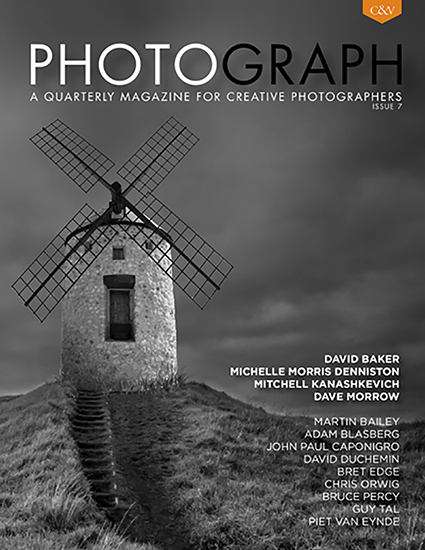PHOTOGRAPH eMagazine – Issue 7

PHOTOGRAPH 7 is out. This issue showcases portfolios from David Baker (Sea Fever), Michelle Morris Denniston, Mitchell Kanashkevich (Vanuatu), and Dave Morrow (nightscapes). The featured article is from Bret Edge, and the usual columnists are here, including Bruce Percy’s Natural Light column including a new column by Guy Tal.
In my column Creative Composition I discuss Pattern.
Here’s an excerpt.
“Many of the mysteries of the universe have been discovered by recognizing and describing patterns. The Golden Section/Ratio (8:5), the Fibonacci Series (1,2,3,5,8,13,21, etc), and the Mandelbrot Set (a shape characterized by repetitions of self-similar forms at all scales) are three examples of patterns that have been used for many different purposes – scientific, industrial, architectural, aesthetic, etc. Discover the type of repetition or change associated with a pattern and you too will unlock the key to understanding it – and possibly a universal principle.
People are pattern seeking / making animals. Even when patterns are absent, we experience them through our own projections. Making images is all about sensing and creating patterns. The same could be said of making any form of art – including life. Life itself follows patterns. You can make your images livelier by using the power of pattern; the clearer you make the pattern, the stronger the image. Increase your powers of pattern recognition and you’ll increase your visual versatility. Increase your sensitivity the unique qualities of each pattern as well as its differences from other patterns and you’ll increase the depth of your expression.
The modernist painter Josef Albers said, “A pattern is interesting. A pattern interrupted is more interesting.” Interrupting a pattern is a visual strategy that tends to produce strongly organized yet dramatic images. The pattern provides the organization. The interruption provides the drama. The pattern makes the images easily grasped, setting up expectations that are reversed by the interruption, like an unexpected plot twist in a story. An interesting distinction can be made between two different kinds of interruption; accents simply interrupt patterns; counterpoints not only interrupt patterns but they do so in ways that contrast with either the pattern or the main message of an image; both accents and counterpoints often become the new focus of the image.
Once you start seeing patterns you won’t be able to stop – and neither will anybody else. Understand the patterns you are naturally drawn to and you’ll better understand your visual voice and creative intentions – and if you make those patterns clear to others they will too. Because pattern is so powerful, it doesn’t take much; some artists have spent a lifetime exploring just one of these universal, organizing principles. Of course, you’re not limited to one pattern and there are so many to choose from. Simply use the power of pattern in your images and you’ll make your images more powerful.”
There’s more similar content in this and every issue of PHOTOGRAPH.
Download PHOTOGRAPH 7 here.


No Comments